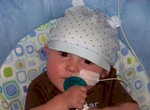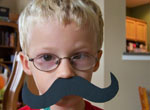QUAD-FAQ
Over the years, I’ve been asked many questions about the accident and my disability. I’ve always made it a personal policy to be as approachable as possible, and to answer every question posed to me. So far, there hasn’t been a question that I would not, or have not, answered. Here are some of the questions that have been asked most frequently over the years: Some of these questions might seem stupid to you. Well, many questions are asked by children, but you’d be surprised how many "adults" don’t know the answers either. Anyway, I don’t consider any questions stupid when someone’s trying to learn. Also, these answers are tailored to me; it may be very different for others in my condition. If there’s a question you have that’s not covered below, please feel free to e-mail me and ask!
Q: What’s the difference between a paraplegic and a quadriplegic?
A: That’s an excellent question; click here for a pretty good explanation.
Q: How did you become paralyzed?
A: It happened in a diving accident in Ocean City, NJ. For all the details, see my story, Just the Beginning.
Q: How old were you when it happened?
A: I was eighteen years old. For all the details, see my story, Just the Beginning.
Q: Do you have any movement?
A: I do have some movement, but nothing really practical. I can shrug my shoulders very well, and I have some pretty good movement in my left arm using my biceps. However, I have no use of either hands, or my legs.
Q: Can you feel anything?
A: I can feel from my chest up, and from my elbows up. Starting at the top of my shoulders, the sensation starts to diminish as you move down closer to my chest and elbows, but there is still feeling. Below these points, I have no external feeling whatsoever.
Q: Can you tell when you’re hungry?
A: Although I have no external feeling from the chest down, I can still feel all the internal drives such as hunger, sexual drives, and fatigue. I can also feel sensations such as when I have an upset stomach.
Q: Can you have sex?
A: Why, yes, I can. Surprised? Most people are. You can learn more about how this works at the Sexuality page.
Q: Do you ever date?
A: Yes, in fact, I’ve dated several women since my accident. It does take a special person to be able to see past this disability and focus on what I can do, and I’ve been lucky enough to find her. See My Love Life for more.
Q: Do you ever go out anywhere for fun?
A: Yes, I enjoy getting out as much as possible. I usually go to movies, clubs, or over to friends’ homes. I also enjoy the theater, museums, parks… basically any place that’s accessible.
Q: Can/Do you work?
A: Yes I can, and I do. Currently, I work for a local health care insurance company as a computer programmer. For more details, see My Job.
Q: How do you work?
A: Since I’m a computer programmer, naturally, my job is primarily computer based. I use a mouth stick to type and use the mouse. My PC has accessibility features (common to Windows) that make this easier to do. Also, my phone system is tied into the PC, so I can make and answer calls myself. When I’m ready to work, I just need a little help getting set up, then I’m pretty much independent.
Q: How fast can you type using your mouth stick?
A: I actually timed myself once using one of those typing programs; when I’m on a roll, I can get up to around 22 words per minute. Interestingly enough, this is slightly faster than what I was timed at in a high school typing course before the accident.
Q: How do you get ready for bed, or get up in the morning?
A: I need someone to help me get ready. I have people who come in and help me with personal care such as getting in and out of bed, dressing and undressing, showering, brushing my teeth, combing my hair, going to the bathroom, etc. Next time you’re getting ready for bed, or for your day, just think of every thing you need to do. No matter how personal; That’s what I need help with.
Q: How do you eat and drink?
A: I can’t use my arms, so I have to rely on people to help me eat. They feed me by using a regular fork or spoon, and just shovel it in. I prefer to drink using a straw, but sometimes drink straight from a cup if necessary.
Q: Do you have a special diet?
A: I pretty much eat whatever I want, whenever I want. There are some foods I might steer away from, but it’s my own choice. I also drink water and cranberry juice as much as I can, because it’s good for the kidneys and bladder. However, I also drink soda and, occasionally, beer.
Q: How do you go to the bathroom?
A: A have a catheter that goes directly into my bladder, though my abdomen. It’s attached to a catheter bag, which is strapped to my leg throughout the day. The urine empties into the bag, which someone needs to empty for me periodically during the day. It’s an easy procedure of unclamping the bag and letting it flow into the toilet, or some other waste area. No muss, no fuss. Bowel movements are a little more complicated. I go during a scheduled bowel routine, three times a week. It involves suppositories and digital stimulation. Since it’s scheduled, I know when I’m going to go, and this is how I avoid "involuntaries."
Q: Do you sleep in your wheel chair?
A: While I have been known to take a little nap now and again in my chair, I do not sleep in it all night. The chair does recline to a horizontal position, so I could sleep in it if I had to, but I sleep in a regular, hospital-type bed.
Q: Why does your chair recline?
A: I recline my chair for a few reasons, but primarily it’s to protect my skin. Sitting in the same position without moving all day can cause the skin on the bottom and back to break down. While sitting for long periods of time, you periodically shift your weight; most of the time you do it unconsciously. I, however, don’t have that luxury, so I recline the back of my chair from time to time for the same effect. I also recline for general comfort, and I’ve been known to limbo as well.
Q: How do you recline your chair?
A: I have a switch on the head rest of the chair. Using my head, I push it once to recline, and then again to sit up again.
Q: How do you drive your wheelchair?
A: I use an electronic wheelchair with "sip and puff" input. There is a straw connected to a control module that is hooked directly to the drive motors. While sitting still, if I puff hard into the straw, I’ll go straight forward until I sip hard to stop. The longer I maintain this hard puff, the faster the chair goes. Also, when I get to the speed I want, I can stop puffing, and it will maintain that speed until I give a hard sip to slow down or stop. If I sip hard while sitting still, I’ll go straight backward until I puff hard. If I give a soft, steady puff into the straw, the chair will turn right. A soft, steady sip turns the chair left.
Q: How long did it take you to learn how to drive your chair?
A: I started to pick it up right away, but it took a couple months of practice to start buzzing around with some proficiency. I must admit that I took out a few ankles in this time, and at least one major piece of furniture.
Q: Can you drive anything else, like a car or van?
A: Well, I’m told that sip and puff technology (see "How do you drive your wheelchair?") can be adapted to a van, but I wouldn’t trust it. I do have a van with a wheelchair lift, but I rely on others to drive it.
Q: How do you do it; Maintain such a positive outlook?
A: Many people look at me and think I deal with my situation very well. To be honest, I’m not so positive about this 100% of the time. I try to take life day by day, but, like everyone else, I do have my down times. I still get depressed, even angry, that I’m like this. Mostly, though, I try to remain as positive as possible, and it’s my sense of humor that gets me through. Also, the incredible support I get from my family and friends always helps things seem better.



